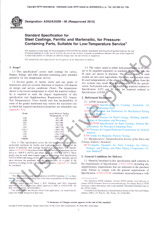We need your consent to use the individual data so that you can see information about your interests, among other things. Click "OK" to give your consent.
ASTM E1530-19
Standard Test Method for Evaluating the Resistance to Thermal Transmission by the Guarded Heat Flow Meter Technique
Translate name
STANDARD published on 1.2.2019
The information about the standard:
Designation standards: ASTM E1530-19
Note: WITHDRAWN
Publication date standards: 1.2.2019
SKU: NS-937098
The number of pages: 8
Approximate weight : 24 g (0.05 lbs)
Country: American technical standard
Category: Technical standards ASTM
The category - similar standards:
Annotation of standard text ASTM E1530-19 :
Keywords:
heat flow meter, heat flux transducer, thermal conductance, thermal conductivity, thermal resistance, thin specimen,, ICS Number Code 17.200.10 (Heat. Calorimetry)
Additional information
| Significance and Use | ||||||||||||||
|
5.1 This test method describes a procedure to measure and compare the thermal resistance properties of specimens (less than 25 mm in thickness) under controlled conditions. |
||||||||||||||
| 1. Scope | ||||||||||||||
|
1.1 This test method describes a steady-state technique for the determination of the resistance to thermal transmission (thermal resistance) of materials having a thickness of less than 25 mm. Thermal conductivity may be determined for homogeneous opaque solid specimens (see Note 1). This test method is particularly useful for homogeneous, multilayer, and composite specimens having a thermal resistance in the range from 10 (cm)2·K·W-1 to 400 (cm)2·K·W-1, which may be obtained from materials with an approximate thermal conductivity range 0.1 W·m-1·K-1 to 30 W·m-1·K-1 over the approximate temperature range from 150 K to 600 K. It can be used outside these ranges with reduced accuracy for thicker specimens and for thermal conductivity values up to 60 W·m-1·K-1. Note 1: A body is considered homogeneous when the property to
be measured is found to be independent of specimen
dimensions.
1.2 This test method is similar in concept to Test Method C518, but is modified to accommodate smaller test specimens, having a higher thermal conductance. In addition, significant attention has been paid to ensure that the thermal resistance of contacting surfaces is minimized and reproducible. 1.3 The values stated in SI units are to be regarded as standard. No other units of measurement are included in this standard. 1.4 This standard does not purport to address all of the safety concerns, if any, associated with its use. It is the responsibility of the user of this standard to establish appropriate safety, health, and environmental practices and determine the applicability of regulatory limitations prior to use. 1.5 This international standard was developed in accordance with internationally recognized principles on standardization established in the Decision on Principles for the Development of International Standards, Guides and Recommendations issued by the World Trade Organization Technical Barriers to Trade (TBT) Committee. |
||||||||||||||
| 2. Referenced Documents | ||||||||||||||
|



 Cookies
Cookies
